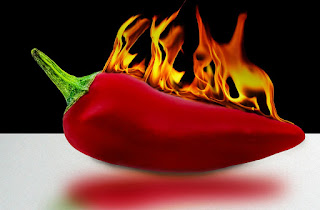 |
| Assorted bell pepper fruits from Mexico (Photo credit: Wikipedia) |
One of the most common genera of peppers, known as the capsicum, is thought to have been in existence millions of years ago in present-day Bolivia, according to the Chicago Botanic Garden's Information and Resources. But, the first known cultivation of peppers happened in Mexico and Central, as well as South America 10,000 years ago. The probable spread of these crops from Bolivia to these areas is attributed to birds. The capsicums existed mainly in the Americas until about 1600. Christopher Columbus' voyages were helpful in spreading capsicum peppers throughout the world.
The original peppers were tiny and round, unlike most of today's peppers which are long and larger.
What can I do with peppers?
Most commonly, peppers have been used to spice up generally boring foods like rice or corn. Through the years though, people have come up with a whole slew of uses for peppers from making pepper jelly, to using ornamental peppers for garlands. Here's a list of the most interesting as well as some of the more common uses for peppers:
Pickled Peppers
Pepper Jelly - Dried Apricot Jalapeno Jelly
Roasted Peppers
Adding Peppers to pasta dishes
Hot Sauce
Pepper Garlands/Decorations
Using peppers in the stirfry
Pepper vinegar
Pepper spray (animal deterrent for plants)
What different types of peppers are there?
There all sorts of classifications for peppers. There is the scientific classification method that uses the genus and species name: The most commonly known and cultivated genus of peppers is the capsicum, whereas the five most common species of peppers (all within the capsicum category) include: chinense, frutescens, pubescent, annum, and baccatum. All of these types of peppers are also labelled chillies.
There is the usage method which categories various peppers into hot, sweet, or ornamental. And then, there is the location-classified method that is what gives some peppers its actual name.
Here's a basic list of some of the varieties of the mentioned species of peppers you might see in your local grocery stores:
Bell pepper
Anaheim pepper
Fresno
Poblano
Habanero
Cubanelle
Chipotle
Jalapeno
Serrano
Mariachi
Aside from the different coloured bell peppers used in stirfry, many of these other peppers are considered hot peppers.
How can you tell how hot a pepper is?
The range of spiciness for peppers is measured in Scoville units. Wilbur Scoville developed a scale to help determine this very issue and measure pepper pungency in 1912. The higher the number of Scoville units, the hotter the pepper. Here's a basic Scoville Scale. that shows habaneros trumping chipotles and jalapenos as the most commonly known hottest pepper.
Health Effects
Regular pepper consumption is thought to have both good and bad effects on one's health. One of the clearest effects of eating peppers is what it does for congestion. Eating peppers, especially those hot ones, will help clear up your nasal passages in no times (as will most spicy foods!)
According to a University study, consuming peppers regularly can help the body control its amount of insulin, which would be very beneficial for diabetics. Other studies show though that pepper digestion can increase the risks of stomach cancer, the definite answer remains unclear. Research has also been linking peppers to helping stop the spread of prostate cancer in some men.
Pepper Recipes (see Recipe4Living.com for the following:)
Pepper Sauce
Basic Salsa
Salsa Cruda
Crowd-Pleasing Chili
Roast Beef and Red Pepper Sandwiches
Impossibly Easy Roasted Red Peppers and Feta Cheese Pie
Tangy Lemon Pepper Shrimp
Stuffed Peppers
Pepper Herb Grilling Rub
Sources:
Chicago Botanic Gardens
The Scoville Scale

